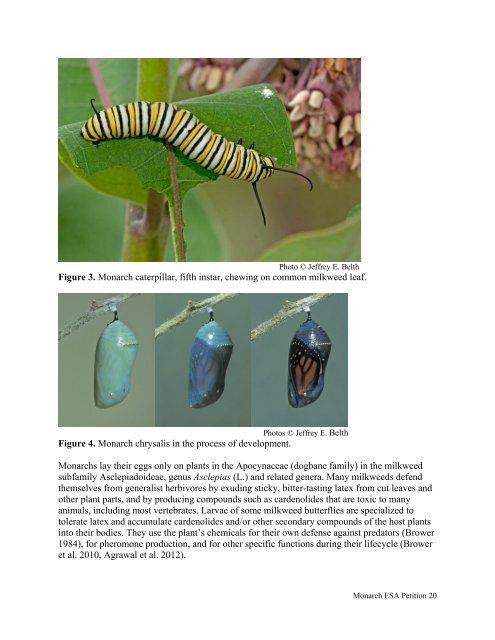- Page 1 and 2: BEFORE THE SECRETARY OF THE INTERIO
- Page 3 and 4: PETITIONERS The Center for Biologic
- Page 5 and 6: TABLE OF CONTENTS Executive Summary
- Page 7 and 8: Though monarchs are found in relati
- Page 9 and 10: threatened by logging, forest disea
- Page 11 and 12: overwintering habitat in 2002 kille
- Page 13 and 14: The monarch was very recently a hig
- Page 15 and 16: when timely action is not undertake
- Page 17 and 18: DESCRIPTION Photo © Jeffrey E. Bel
- Page 19: Based on the short amount of time s
- Page 23 and 24: legumes (Fabaceae spp.), goldenrod
- Page 25 and 26: Monarch butterflies in western Nort
- Page 27 and 28: Figure 8. Western monarch collectio
- Page 29 and 30: Cardenolide fingerprinting of monar
- Page 31 and 32: managers than roost sites (Brower e
- Page 33 and 34: POPULATION DISTRIBUTION AND STATUS
- Page 35 and 36: land was invaded by common milkweed
- Page 37 and 38: Mexico, the Monarch Larva Monitorin
- Page 39 and 40: Figure 13. Western Monarch Thanksgi
- Page 41 and 42: almost a billion individuals were i
- Page 43 and 44: When butterflies were collected for
- Page 45 and 46: change, and stochastic weather even
- Page 47 and 48: Pesticide usage figures from USDA
- Page 49 and 50: Figure 18. Estimated Agricultural U
- Page 51 and 52: Figure 20. A: Percentage of U.S. so
- Page 53 and 54: In sum, the limited and early-seaso
- Page 55 and 56: The Iowa and Minnesota surveys exem
- Page 57 and 58: 1999 accounted for 56 percent of th
- Page 59 and 60: In response, all of the major agric
- Page 61 and 62: iodiversity in agriculture-dominate
- Page 63 and 64: to butterflies, especially with fre
- Page 65 and 66: action of glyphosate and either 2,4
- Page 67 and 68: Brower et al. (2012a) identify loss
- Page 69 and 70: portion of Sierra Campanario. Loggi
- Page 71 and 72:
and 21 additional hectares were imp
- Page 73 and 74:
for some natural areas (Internation
- Page 75 and 76:
international community and Mexican
- Page 77 and 78:
and California, monarchs are able t
- Page 79 and 80:
numbers of butterflies being in the
- Page 81 and 82:
Petition, Loss of Monarch Habitat i
- Page 83 and 84:
Additionally, FWS will phase out th
- Page 85 and 86:
Private Lands The vast majority of
- Page 87 and 88:
Vidal et al. (2013) identify small-
- Page 89 and 90:
As explained elsewhere in this peti
- Page 91 and 92:
Neonicotinoids include imidacloprid
- Page 93 and 94:
Figure 26. Increasing imidacloprid
- Page 95 and 96:
Figure 29. Increasing clothianidin
- Page 97 and 98:
2012, Nuyttens et al. 2013). This d
- Page 99 and 100:
most commonly used adulticides are
- Page 101 and 102:
Global Climate Change The monarch b
- Page 103 and 104:
availability (Cockrell et al. 1993,
- Page 105 and 106:
Severe Weather and Catastrophic Eve
- Page 107 and 108:
two highly invasive swallow-wort sp
- Page 109 and 110:
that the entire North American rang
- Page 111 and 112:
and Oberhauser 2012). There is also
- Page 113 and 114:
the species at the time it is liste
- Page 115 and 116:
Baldwin, F.L. 2011. Glyphosate drif
- Page 117 and 118:
Brower, A.V. Z., and M. M. Jeansonn
- Page 119 and 120:
http://libcloud.s3.amazonaws.com/93
- Page 121 and 122:
Cleary Chemical Corporation. 2006.
- Page 123 and 124:
Dockx, C. 2007. Directional and sta
- Page 125 and 126:
Franz, J.E., M.K. Mao, and J.A. Sik
- Page 127 and 128:
Hartzler, R.G., and D.D. Buhler. 20
- Page 129 and 130:
Johal, G.S. and J.E. Rahe. 1984. Ef
- Page 131 and 132:
Lindenmayer, D.B., J.T. Wood, L. Mc
- Page 133 and 134:
Meade, D.E. 1999. Monarch butterfly
- Page 135 and 136:
permethrin barrier treatments. Envi
- Page 137 and 138:
Rasmussen, N. 2001. Plant hormones
- Page 139 and 140:
the Linnean Society 144:191-212. Av
- Page 141 and 142:
http://www.nrcs.usda.gov/Internet/F
- Page 143 and 144:
U.S. Environmental Protection Agenc
- Page 145 and 146:
Wyatt, R., A. Stoneburner, S.B. Bro
- Page 147 and 148:
Appendix A: Non-migratory Populatio
- Page 149 and 150:
2004). These milkweeds also have be
- Page 151 and 152:
y one or a few butterflies and then
- Page 153 and 154:
Philippines Although monarchs were
- Page 155 and 156:
Resident monarchs have also been st
- Page 157 and 158:
Danaus plexippus (Lepidoptera: Dana
- Page 159:
Appendix B: Proposed Rules to Facil




